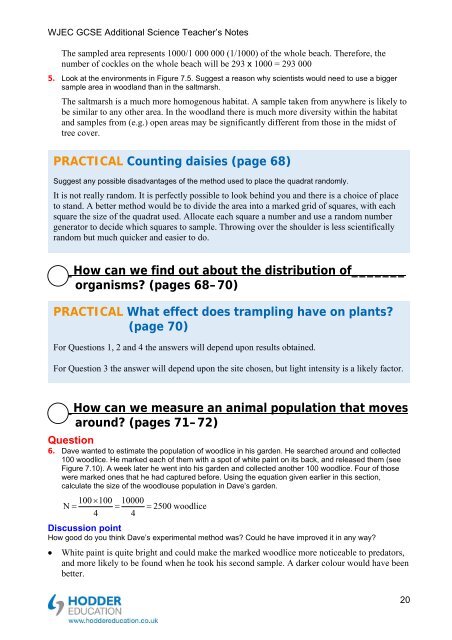Teacher's notes and answers to questions in the book - Hodder Plus ...
Teacher's notes and answers to questions in the book - Hodder Plus ...
Teacher's notes and answers to questions in the book - Hodder Plus ...
Create successful ePaper yourself
Turn your PDF publications into a flip-book with our unique Google optimized e-Paper software.
WJEC GCSE Additional Science Teacher’s Notes<br />
The sampled area represents 1000/1 000 000 (1/1000) of <strong>the</strong> whole beach. Therefore, <strong>the</strong><br />
number of cockles on <strong>the</strong> whole beach will be 293 x 1000 = 293 000<br />
5. Look at <strong>the</strong> environments <strong>in</strong> Figure 7.5. Suggest a reason why scientists would need <strong>to</strong> use a bigger<br />
sample area <strong>in</strong> woodl<strong>and</strong> than <strong>in</strong> <strong>the</strong> saltmarsh.<br />
The saltmarsh is a much more homogenous habitat. A sample taken from anywhere is likely <strong>to</strong><br />
be similar <strong>to</strong> any o<strong>the</strong>r area. In <strong>the</strong> woodl<strong>and</strong> <strong>the</strong>re is much more diversity with<strong>in</strong> <strong>the</strong> habitat<br />
<strong>and</strong> samples from (e.g.) open areas may be significantly different from those <strong>in</strong> <strong>the</strong> midst of<br />
tree cover.<br />
PRACTICAL Count<strong>in</strong>g daisies (page 68)<br />
Suggest any possible disadvantages of <strong>the</strong> method used <strong>to</strong> place <strong>the</strong> quadrat r<strong>and</strong>omly.<br />
It is not really r<strong>and</strong>om. It is perfectly possible <strong>to</strong> look beh<strong>in</strong>d you <strong>and</strong> <strong>the</strong>re is a choice of place<br />
<strong>to</strong> st<strong>and</strong>. A better method would be <strong>to</strong> divide <strong>the</strong> area <strong>in</strong><strong>to</strong> a marked grid of squares, with each<br />
square <strong>the</strong> size of <strong>the</strong> quadrat used. Allocate each square a number <strong>and</strong> use a r<strong>and</strong>om number<br />
genera<strong>to</strong>r <strong>to</strong> decide which squares <strong>to</strong> sample. Throw<strong>in</strong>g over <strong>the</strong> shoulder is less scientifically<br />
r<strong>and</strong>om but much quicker <strong>and</strong> easier <strong>to</strong> do.<br />
_How can we f<strong>in</strong>d out about <strong>the</strong> distribution of_______<br />
organisms (pages 68–70)<br />
PRACTICAL What effect does trampl<strong>in</strong>g have on plants<br />
(page 70)<br />
For Questions 1, 2 <strong>and</strong> 4 <strong>the</strong> <strong>answers</strong> will depend upon results obta<strong>in</strong>ed.<br />
For Question 3 <strong>the</strong> answer will depend upon <strong>the</strong> site chosen, but light <strong>in</strong>tensity is a likely fac<strong>to</strong>r.<br />
_How can we measure an animal population that moves<br />
around (pages 71–72)<br />
Question<br />
6. Dave wanted <strong>to</strong> estimate <strong>the</strong> population of woodlice <strong>in</strong> his garden. He searched around <strong>and</strong> collected<br />
100 woodlice. He marked each of <strong>the</strong>m with a spot of white pa<strong>in</strong>t on its back, <strong>and</strong> released <strong>the</strong>m (see<br />
Figure 7.10). A week later he went <strong>in</strong><strong>to</strong> his garden <strong>and</strong> collected ano<strong>the</strong>r 100 woodlice. Four of those<br />
were marked ones that he had captured before. Us<strong>in</strong>g <strong>the</strong> equation given earlier <strong>in</strong> this section,<br />
calculate <strong>the</strong> size of <strong>the</strong> woodlouse population <strong>in</strong> Dave’s garden.<br />
100 100<br />
10000<br />
N 2500 woodlice<br />
4 4<br />
Discussion po<strong>in</strong>t<br />
How good do you th<strong>in</strong>k Dave’s experimental method was Could he have improved it <strong>in</strong> any way<br />
<br />
White pa<strong>in</strong>t is quite bright <strong>and</strong> could make <strong>the</strong> marked woodlice more noticeable <strong>to</strong> preda<strong>to</strong>rs,<br />
<strong>and</strong> more likely <strong>to</strong> be found when he <strong>to</strong>ok his second sample. A darker colour would have been<br />
better.<br />
20

















